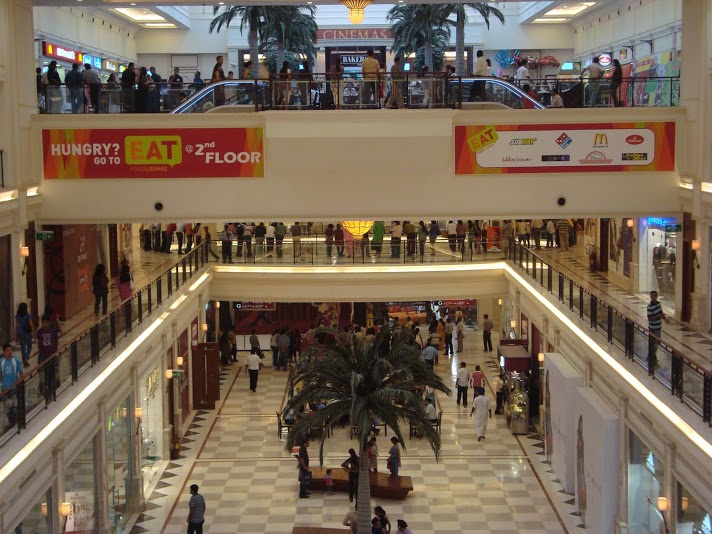
The first site to visit for our SINGLE team’s collective fieldwork in Delhi was the DLF Emporio, the most premium shopping mall in India, on Gandhi’s birthday. Although shopping malls have been an integral and indispensable part of my experiences of living and travelling in major East Asian metropolises, this visit has denaturalized my past access to shopping spaces and revealed the strategies of exclusion and hierarchization in malls.
(Image source: By Siddhartha (Own work) [CC BY-SA 3.0 (http://creativecommons.org/licenses/by-sa/3.0)], via Wikimedia Commons))
Emporio first disrupts my past understanding of shopping malls by its physical isolation and seclusion (see Figure 1). Three malls, Emporio, Promenade and Ambience, conjoin but stand proudly alone, like a magnificent palace in its own kingdom, or a mirage in a desert. The complex is not meant as a shopping center serving the surrounding neighborhood, but a national pilgrimage site for the “new generation of affluent and fashion-conscious Indians.” Besides, separated from nearby buildings by wide roads, they seem only reachable by cars. Therefore, inclusion to Emporio is firstly predicated on the potential consumers’ automobility, while in Shanghai the metro takes me to all major malls or maybe I simply ignore places that I cannot reach via public transportation.
Upon entrance to Emporio, a security check is performed. My impression is that my foreignness has exempted me from the profiling and labeled me eligible for this place. What I wear, what bag I hold, and what credit card I use suddenly become irrelevant markers of my social economic status, instead my foreign face alone gives me a pass to freely browse in luxury brands’ stores. I can imagine the domestic consumers have to resort to certain performances of identities and statuses to win legitimacy to enter and use this consumption space. This propels me to realize how I implement a sort of self-censorship or self-exclusion in several high-end malls in Shanghai: to avoid the luxury brands, I stick to the underground floors where fast fashion chains exist or the top floors where fast food chains gather. Clearly, malls hierarchize spaces.
In Emporio, western luxury brands are located on the ground and first floors, while Indian brands on the second and third floors. The level of luxury and renown is spatially constructed, and consequently the West and India are hierarchized. And on Gandhi’s birthday, a national holiday, most Indian brands’ stores are closed possibly due to a lack of consumers while the lower floors are bright and shinning as ever. Another aspect of spatial hierarchization takes place between Emporio and the adjacent Promenade and Ambience. Compared to the former, the latter two are less luxury, more squeezed with stores and more crowded with a bigger variety of consumers (See Figure 2 for a comparison of the dinning spaces). Emporio as a pilgrimage site is a sanitized space by excluding mass entertainment facilities like the cinema yet staging the piano, as well as excluding hidden (dirty) kitchens yet providing coffee, cakes, and Indian street food made by chefs working in an open kitchen. In contrast, in Promenade the food court is crowded and customers need to be assertive in order to get seats; the passages are difficult to get through as young people stroll in groups and change their minds all the time. This space harbors more social activities and interactions, exhibiting a rather chaotic rhythm. As I observe, many customers walk from one mall to another, I wonder if they consciously change their identity performances when they traverse spaces as the mode of control switches. Although I experience Emporio mostly as a highly controlled space, as a relatively new space I believe it nonetheless offers new possibilities of social interactions for its clientele, albeit very small and exclusive, and spatial appropriations as my lengthy time spent in malls always reminds me the boundary between the public and the private constantly changes in consumption spaces.